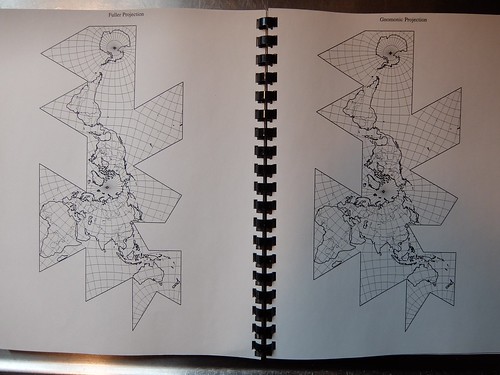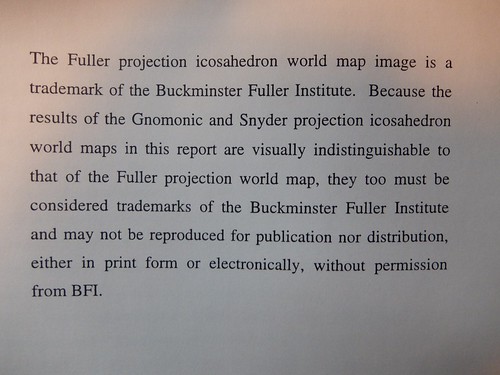I'm at the Portland Python User Group at Urban Airship (@PDXPython), the main Python user group in town, though the Monday Night Circus @ <guild /> is also well attended, and more informal. Some of the same people go to both (hi Ben).
Here we gather for presentations and sometimes pizza. Tonight Cloudbolt Software is getting to sponsor. The pizza is not here yet.
Trevor does a better job of archiving the Bucky stuff in the meticulous fashion researchers require. The Linus and Ava Helen Pauling collection at Oregon State, with the Douglas Strain Reading Room, showed me what a state of the art archives is all about.
Trevor is uber diligent even in the absence of much funding, which is characteristic of those who bring order to Fuller's work. Not being paid is part of what makes it work, hard work.
I'll plan to get him these materials uncovered above. The paper by Dr. Bob Gray shows how the characteristic arrangement of continents that go into making up the Fuller Projection is really what makes it stand out.
Using the Snyder or Genomic Projection algorithms, as distinct from Fuller's, results in mathematically measurable differences, but to the naked eye, the distortion is about the same i.e. minimal (compared to a Mercator, which takes the flat Earth perspective to an extreme).
Dr. Ernest Bonat, Senior Software Engineer, will address us tonight, on the topic of Implementing MVC Arcitecture in Python for Data Analysis. He works full time at Intel, but does data analysis consulting on the side.
He's here to tell us about his stack, 64-bit Windows based (Core i7, 16 GM RAM). Getting all the software in one place is his goal: Anaconda is his solution. He's Cuban, not Italian -- he wanted us to know. Eclipse IDE / PyDev plugin / EGit plugin (free) is a good one. Microsoft is providing quite a lot for free these days, community edition everything, Python tools for Visual Studio, SQL Server etc.
I've used Eclipse a lot, our defacto IDE at O'Reilly School, but since getting Anaconda I've been practicing with Spyder a lot. PyCharm is an old standby as well, and popular with this audience (we did a show of hands). I'm glad he's showcasing Eclipse.
Pycon is next week, May 28 through June 5th. This particular Pycon, organized directly by the Python Software Foundation, is the largest annual gathering for the community using and developing the open source Python programming language. Steve Holden got the ball rolling on Pycons. EuroPython was first.
Steve is not coming to Pycon this year, which is unfortunate. I'll be hosting Henrique from Brazil as my guest.
Cloudbolt is looking for a full stack engineer. The pizza has arrived!
I heard some grumbling that Bonat's version of MVC is treating Visualizations more as reports (final output) than a full interactive GUI controlled by the end-user. In web development, the visualization is more or less synonymous with the web page presentation itself.
Ernest's end users are client-recipient of the data analysis, not the real time users of a custom GUI. Ernest himself is happy running his source code directly, given everything is so well organized. For him, Eclipse itself is the GUI. The data went from .csv files into pandas. This was not Big Data in the sense of mapreduce or Hadoop.
Dr. Bonat was certainly right to emphasize unit testing and TDD. When it comes to job interviews, he's looking for well commented, documented solutions that come with unit tests. I need to keep that in mind as a job hunter.
The Lightning Talk was also interesting and statistical in nature, though also more number theoretic. How many digits does it take to represent a natural number 1/n, including one digit to designate "repeating"? For example 0.5 is 1 digit for 1/2, whereas 0.333... for 1/3 would be 2 digits, as the 3 repeats.
The speaker, who's name I missed, showed us several plots, including varying the number base. Bases of a 2nd power, like 4 and 9, have special properties apparently. Primes especially often take as many digits as in the base to represent the number.
On the way to the meetup I was communicating with Trevor about getting him the above materials. I also sent him this link to recent writing, on 4D vs. 4D vs. 4D, a theme of my enthno-mathematical investigations.


